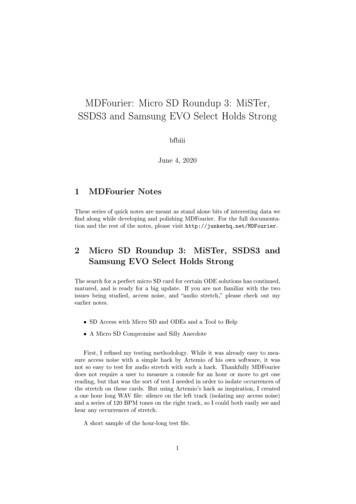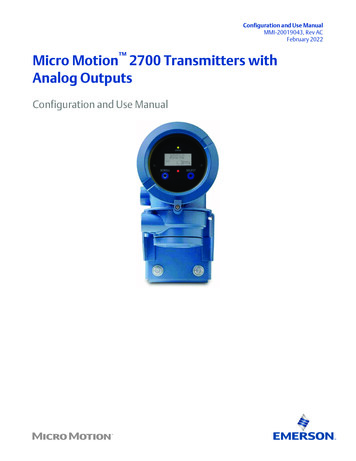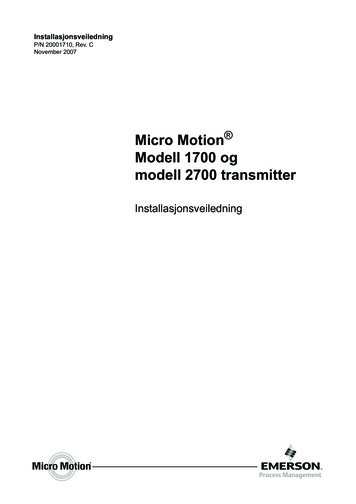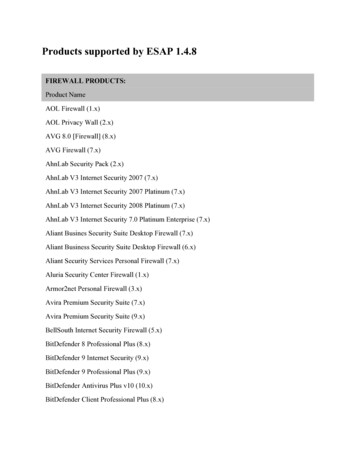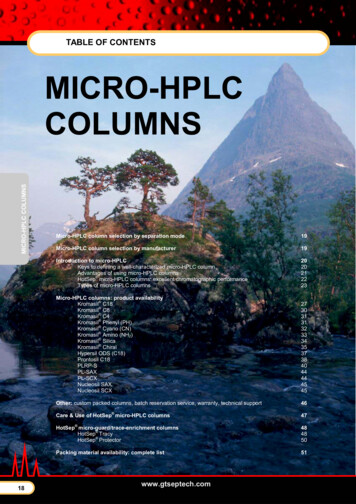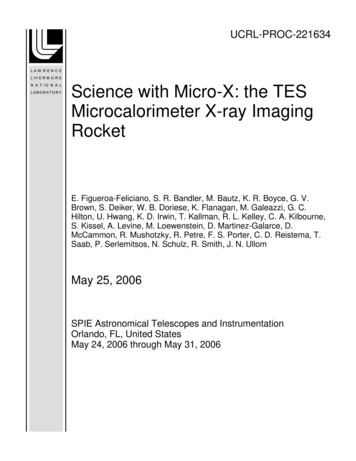
Transcription
UCRL-PROC-221634Science with Micro-X: the TESMicrocalorimeter X-ray ImagingRocketE. Figueroa-Feliciano, S. R. Bandler, M. Bautz, K. R. Boyce, G. V.Brown, S. Deiker, W. B. Doriese, K. Flanagan, M. Galeazzi, G. C.Hilton, U. Hwang, K. D. Irwin, T. Kallman, R. L. Kelley, C. A. Kilbourne,S. Kissel, A. Levine, M. Loewenstein, D. Martinez-Galarce, D.McCammon, R. Mushotzky, R. Petre, F. S. Porter, C. D. Reistema, T.Saab, P. Serlemitsos, N. Schulz, R. Smith, J. N. UllomMay 25, 2006SPIE Astronomical Telescopes and InstrumentationOrlando, FL, United StatesMay 24, 2006 through May 31, 2006
DisclaimerThis document was prepared as an account of work sponsored by an agency of the United StatesGovernment. Neither the United States Government nor the University of California nor any of theiremployees, makes any warranty, express or implied, or assumes any legal liability or responsibility forthe accuracy, completeness, or usefulness of any information, apparatus, product, or processdisclosed, or represents that its use would not infringe privately owned rights. Reference herein to anyspecific commercial product, process, or service by trade name, trademark, manufacturer, or otherwise,does not necessarily constitute or imply its endorsement, recommendation, or favoring by the UnitedStates Government or the University of California. The views and opinions of authors expressed hereindo not necessarily state or reflect those of the United States Government or the University of California,and shall not be used for advertising or product endorsement purposes.
Science with Micro-X: the TES Microcalorimeter X-rayImaging RocketE. Figueroa-Felicianoa,b , S. R. Bandlerc,d , M. Bautzb , K. Boycec , G. Browne , S. Deikerf ,W. B. Dorieseg , K. Flanaganb , M. Galeazzih , G. C. Hiltong , U. Hwangc , K. D. Irwing ,T. Kallmanc , R. L. Kelleyc , C. A. Kilbournec , S. Kisselb , A. Levineb , M. Loewensteinc,d ,D. Martinez-Galarcef , D. McCammoni , R. Mushotzkyc , R. Petrec , F. S. Porterc ,C. D. Reistemag , T. Saabj , P. Serlemitsosc , N. Schulzb , R. Smithc , J. N. Ullomga Departmentof Physics, Massachusetts Institute of Technology, Cambridge, MA 02139, USA;Kavli Institute for Astrophysics and Space Research, Cambridge, MA 02139, USA;c NASA Goddard Space Flight Center, Greenbelt, MD 20770, USA;d University of Maryland, Department of Astronomy, College Park, MD 20742, USA;e High Energy Density Physics and Astrophysics Division, Lawrence Livermore NationalLaboratory, Livermore, CA 9455;f Lockheed Martin Solar and Astrophysics Laboratory, 3176 Porter Dr., Palo Alto, CA 94304;g National Institute of Standards and Technology, 325 Broadway, Boulder, CO 80305, USA;h University of Miami, Department of Physics, Coral Gables, FL 33146, USA;i Department of Physics, University of Wisconsin-Madison, Madison, WI 53706, USA;j Deptartment of Physics, University of Florida, Gainsville, FL 32611, USAb MITABSTRACTMicro-X is a proposed sounding rocket experiment that will combine a transition-edge-sensor X-ray-microcalorimeterarray with a conical imaging mirror to obtain high-spectral-resolution images of extended and point X-ray sources.We describe the payload and the science targeted by this mission including the discussion of three possible MicroX targets: the Puppis A supernova remnant, the Virgo Cluster, and Circinus X-1. For example, a Micro-Xobservation of the bright eastern knot of Puppis A will obtain a line-dominated spectrum with 90,000 countscollected in 300 seconds at 2 eV resolution across the 0.3-2.5 keV band. Micro-X will utilize plama diagnosticsto determine the thermodynamic and ionization state of the plasma, to search for line shifts and broadeningassociated with dynamical processes, and seek evidence of ejecta enhancement. For clusters of galaxies, Micro-Xcan uniquely study turbulence and the temperature distribution function. For binaries, Micro-X’s high resolutionspectra will separate the different processes contributing to the Fe K lines at 6 keV and give a clear view of thegeometry of the gas flows and circumstellar gas.Keywords: Supernova Remnants, Clusters of Galaxies, X-ray binaries, X-rays, Microcalorimeters, SoundingRockets1. INTRODUCTIONThe promise of imaging, high resolution X-ray spectroscopy remains unfulfilled. The unfortunate loss of theSuzaku X-ray Spectrometer (XRS) and the delay of Constellation-X leaves the X-ray astronomy communitywithout a certain prospect of fulfilling the original AXAF scientific objectives for many years. The JapaneseNew X-ray Telescope (NeXT) mission is the most likely next advance, but its launch date is still uncertain. Thelack of flight opportunities is especially frustrating given the technical readiness of X-ray microcalorimeters. Wepropose to fill this gap in scientific capability with Micro-X, a sounding rocket payload that combines an X-raymicrocalorimeter with an imaging mirror to offer breakthrough science from high spectral resolution observationsof extended X-ray sources.E. Figueroa-Feliciano’s e-mail: enectali@mit.edu
Energy Resolution EEffective Area @ 1 keVPoint Spread FunctionMirror Focal LengthFOVSize of Detector ArrayPixel SizeBandpass22002.52.114.411 118001.30.3-2.5eV FWHMcm2arcminmarcminµmarcminkeVTable 1. Micro-X Technical SpecificationsMicro-X will consist of a Transition Edge Sensor (TES) microcalorimeter array at the focus of a flight-provenconical imaging mirror. Progress in the last decade now allows routine fabrication of microcalorimeter arrayswith energy resolutions from 2.5–4.7 eV FWHM reported by various groups;1, 2 these approach the theoreticalresolutions of 1–2 eV.3Micro-X will offer a unique combination of bandpass, collecting area, and spectral and angular resolution. Thespectral resolution across the 0.3-2.0 keV band will be 2 eV. The angular resolution across the 14.4 arc minutefield of view will be 2.5 arc minutes. The effective area, 200 cm2 at 1 keV, is sufficient to provide observations ofunprecedented quality of numerous cosmic X-ray sources, discrete and extended, even in a brief sounding rocketexposure.Our scientific program will initially focus on extended sources, for which high-spectral-resolution, wide-energybandwith observations were hitherto impossible. For supernova remnants the Micro-X objectives are to utilizenumerous plasma diagnostics to determine the thermodynamic and ionization state of the plasma, to search forline shifts and broadening associated with dynamical processes, and seek evidence of ejecta enhancement. Forclusters of galaxies, Micro-X can uniquely study turbulence and the temperature distribution function. For ourinitial flight, we will observe the bright eastern knot in the Puppis A remnant, a site of complex cloud-shockinteractions and ejecta enrichment. Other SNRs for which breakthrough observations are possible include theCygnus Loop and Cas A. The center of the Virgo Cluster is the highest priority cluster target. Eventuallythe payload can be reconfigured with the ASCA flight spare mirror to measure the velocity of accreting andoutflowing gas in X-ray binary systems.2. THE MICRO-X PAYLOADWe believe the current generation of TESs are at a technology readiness level ideally suited for a rocket flight.Micro-X is the next logical step to synthesize TES technologies around a flight system. In this section we give abrief overview of the payload. Table 1 summarizes the technical specifications of Micro-X.2.1. Detectors for Micro-XOur reference design for Micro-X consists of an 11 11 array of 0.7 mm 0.7 mm pixels on an 0.8 mm pitch.This odd size array scale was chosen as a reference for modeling based on the availability of a 4x32 SQUID MUXsystem. The physical array may be 12x12, or even 16x16. Coupled to the 2.1 m focal length mirror, each arraypixel will be 1.31 arcmin on the sky, a good match to the 2.5 arcmin imaging of the mirror.We have chosen to limit the complexity of the arrays by foregoing the use of the high-fill-factor X-rayabsorbers under development for Constellation-X. For the soft X-ray array, the TES sensors themselves havesufficient quantum efficiency, and for the broad band array we will apply a bismuth absorber of the same areaas the TES directly to the sensor. This creates a “waffle-like” focal plane with dead region at the wiring gapbetween pixels (see Figure 1). The 77% fill factor is adequate for our observations. We will prevent X-rayinteraction in the electrical leads and silicon structure through use of a mask.
Figure 1. A NIST TES 16 16 array. The dark squares are the TESs. These arrays are designed for Constellation-Xand are built at a 350 µm pitch (with 250 µm TESs). The Micro-X array will use the same “waffle” design.We can apply simple scaling arguments to predict the performance of these arrays. Given that the heatcapacity is largely determined by the TES area, the main variable to adjust is the sensitivity, α.1 demonstrateda 0.4 mm device made at NIST with 3-eV resolution across a broad band. If we were to increase the heatcapacity by 3 (through increasing the area of the TES)pand increase α by 3, we would obtain a 3.4-eV devicewith a saturation energy of 10 keV (Resolution scales as C/α for an ideal device, but the degradation predictedaccounts for an excess noise term that depends on α4 ). Increasing α by a factor of 6 would produce a devicewith 1.9-eV resolution and a saturation energy of 5 keV. The value of α is tuned through adjusting the densityof perpendicular normal metal strips applied to the surface of the TES.4The detectors will be housed in an enclosure with an X-ray aperture. This detector assembly providesmechanical and thermal staging of the TES array and the front-end SQUID amplifiers. It includes suspensionsystems, wiring interfaces, and magnetic shielding.2.2. Readout ElectronicsWe will read out the detector array using a NIST time-division SQUID multiplexer.5–7 In a time-divisionmultiplexer, amplifiers are turned on one at a time, with switching occurring fast enough that each detector issampled faster than the detector time constants of interest. The signals from all first-stage amplifiers (only oneof which is on at a time) are summed. The NIST scheme takes this idea to two dimensions, so that in an array,rows of SQUID amplifiers are turned on sequentially, and each column has its own series-array amplifier. In thiscase, the number of wires to the cold stage necessary to read out an N N detector array scales roughly as 2N ,rather than N 2 for the brute-force readout technique. NIST recently demonstrated that the SQUID TDM canread out the required number of detectors with sufficient energy resolution for Micro-X.82.3. Cryogenic SystemsThe Micro-X ADR cryogenic system will be based on the very successful X-ray Quantum Calorimeter (XQC)sounding rocket refrigerator.9, 10 The Micro-X cryostat will be substantially similar to the XQC system. Somemodifications are required by the TES detector system that complicate the cryostat design, but at the same timethe more restricted field of view of the Micro-X instrument make some parts of the design simpler. The biggestchallenge in the Micro-X cryogenic design is to provide near-zero magnetic field regions in the instrument aroundthe TES detectors and the SQUID amplifiers. We will design an optimal, staged magnetic isolation system for
Figure 2. The Micro-X mirror.the detectors and amplifiers. Local superconducting shields will be designed for the detector system and SQUIDSthat minimize the susceptibility to trap flux.2.4. Mirror and optical benchThe Micro-X instrument will use the imaging mirror from the Supernova X-Ray Spectrometer (SXS), a soundingrocket instrument flown by the GSFC group in 1988 to observe SN 1987A (Figure 2). The mirror is the firstsegmented, thin foil conical mirror ever to have flown. The foil reflectors were lacquer coated using the approachused for the BBXRT and ASCA mirrors. It has a 2.1 m focal length and a 40 cm diameter with 70 nested shellsconfigured in quadrants. The high filling factor of the thin-foil implementation provides 300 cm2 of area at1 keV and a broad energy response. After including filter transmission and detector fill fraction we still have 200 cm2 of effective area (Figure 3). This effective area was used for the simulations in this paper. The optic’smeasured angular resolution is 2.50 (half power diameter).If a bandpass extension beyond 6 keV is desired for study of X-ray binaries, the ASCA flight spare mirrorcan be installed. Use of this mirror would require lengthening of the optical bench to accommodate the longerfocal length (3.5 m). The ASCA mirror would provide Micro-X with 100 cm2 at 6 keV.3. SCIENCE WITH MICRO-XMuch of the detailed physics of astronomical sources is accessible only through spectroscopy. In particular awide variety of kinematic, temperature, ionization, density and abundance diagnostics are available only atmoderate to high spectral resolution (E/dE R 20). Such data have long been available at optical and radiowavelengths, but only the latest generation of missions have made them available to X-ray astronomers. BesidesH and He, all of the abundant elements produce X-ray emission—-in particular, the K-shell transitions of Cthrough Fe, as well as the L-shell transitions of Si through Fe, and the M shell transitions of Fe and Ni. CosmicX-ray spectra can therefore be quite rich, with a multitude of spectral lines conveying fundamental physicalinformation. In contrast to spectra at other wavebands, a single X-ray spectrum can include all the extremes
Figure 3. The Micro-X effective area, including the mirror, the blocking filters, and the TES quantum efficiency andpacking fraction.in the possible charge states of a given element—from fluorescent lines in cold neutral material to lines of thehydrogren-like ion of Fe.For high spectral resolution data, the technique of plasma diagnostics provides a means for unraveling theplasma conditions in a relatively model-free manner. The key requirement is the ability to measure fluxes ofindividual X-ray lines in order to place physical constraints on the emitting plasma. By using ratios of line fluxes,uncertainties in the distance to the source are eliminated. By taking pairs of lines of similar energy from the sameion, uncertainties in column density are minimized, and plasma temperatures may be constrained. Lines fromdifferent ionization states provide information on ionization balance, and lines from different elements provideabundance information.For point sources, the Chandra and XMM-Newton grating spectrometers have amply demonstrated the powerof R 20 spectroscopy.11 The results include measuring precise chemical abundances in stellar coronae,12solidifying the cooling flow mystery in clusters of galaxies13 and discovering massive outflowing winds in activegalaxies.14 While moderate resolution X-ray CCD spectra have long been available for extended sources, highresolution spectra are currently available only in a limited way with Chandra and XMM-Newton. Becausegratings are dispersive spectrometers, they cannot achieve the spectral resolution needed to measure individualline fluxes if the source has a significant angular extent. At best, the XMM RGS spectra are an improvement overCCD spectrometers only for sources smaller than 30 in size. Many of the brightest extended sources in the sky aremuch larger than this, and are thus inaccessible for study at high spectral resolution. This gap in our capabilityshould have been filled by the Suzaku XRS, but its unfortunate demise has prevented this advancement fromcoming to fruition.The vast scientific potential for spectroscopy is discussed in detail by Paerels.11 We highlight a few examples.(1) Resolve the He-like triplet lines of the abundant elements: These lines are strongly sensitive to electrondensity, temperature, and ionization conditions in the emitting plasma. (2) Sensitivity to velocity structure: Forexample, 500 km/s turbulent velocities are predicted in clusters of galaxies and will be imprinted in line profilesand energy shifts.15 (3) Distinguish the source of ionization of the plasma: The exact line energies and strengthswill distinguish between scenarios such as photoionization, collisional and shock ionization. (4) (Partially) resolvethe vast sea of Fe L shell lines in the 0.7–1.4 keV band: These lines dominate the spectrum of collisionally ionizedplasmas with 0.4 kT 2 keV, and are strong even when lower-Z elements are fully stripped. For collisionallyionized plasmas, this complex samples a wide range in temperature and has significant diagnostic sensitivity (seeFigure 6).The Micro-X mission as proposed is designed to obtain high resolution data that will help to answer suchquestions for the brightest large extended objects in the sky, and restore some of the science lost to Suzaku. Here
05E 051E 061.5E 062E 06Figure 4. The Puppis A supernova remnant. The box represents the 14.40 FOV for observation of the Bright EasternKnot by Micro-X.we give two detailed examples of this science: the Puppis A supernova remnant and the giant elliptical galaxyM87 at the core of the Virgo cluster. With these data, we ascertain the temperature and ionization state of theX-ray emitting gas in Puppis A. This is crucial to unravelling the presence of supernova ejecta in this remnant,the turbulent processes that take place as a molecular cloud is torn apart by shocks, and shock-induced starformation. In the case of M87, we can search for the kinematic signature of the heating of the X-ray emitting gasthat must be taking place,16 determine precise chemical abundances for oxygen, nitrogen and neon, and searchfor the origin of the lack of cooling in the gas below 0.6 keV. Similar scientific studies would be possible for 2–3other clusters of galaxies and several other supernova remnants, such as Cas A, Tycho’s SNR and the CygnusLoop.With an upgrade of the mirror to achieve 100 cm2 of effective area at 6 keV, high resolution studies of 6 keVemission from accretion disks around compact objects can be undertaken.3.1. Galactic Supernova RemnantsThe highest priority candidate for the initial Micro-X observation is the Bright Eastern Knot region of thePuppis A supernova remnant (Figure 4). Puppis A is a bright Galactic supernova remnant that was the targetof one of the earliest successful high-resolution spectral observations with the Einstein Focal Plane CrystalSpectrometer.17, 18 These observations were of limited energy range and sensitivity, however, and the spectralresolution of this dispersive instrument was compromised by the large angular scale of the X-ray emission.As a middle-aged remnant, Puppis A straddles the division between young objects that are totally dominatedby their supernova debris, or ejecta, and older remnants that have lost all trace of their ejecta. Despite a ratheradvanced estimated age of 4000 years, it contains both optical and X-ray evidence for supernova ejecta. However,
Figure 5. Simulation of the integrated Puppis A spectrum assuming 300 sec observation by Micro-X with 2 eV resolution.There are 92,900 counts in this simulation. The effective area curve used for this simulation, which includes mirror, filters,and detector efficiencies is shown in Figure 3.it is also very strongly shaped by its interactions with a complex interstellar environment. The Bright EasternKnot (BEK) region of Puppis A is the brightest, and perhaps most complex example of these interactions, withmultiple shocked clouds plus evidence for ejecta enrichment in its vicinity.The main science goals of the Micro-X observation are first to unravel the kinematic, temperature, andionization characteristics of the cloud-shock interactions at the BEK, and second to address the issue of ejectaenrichment of the X-ray emitting gas. Crucial to both of these efforts will be ascertaining the temperaturedistribution of the X-ray emitting gas. This is important for understanding ejecta enrichment because multitemperature gas can mimic enriched abundances in lower resolution spectra if too simple a temperature structureis assumed. A simulated 300 s observation with a 14.4 arcmin field of view at the BEK is shown in Figure 5.The model in Figure 5 is a three-temperature nonequilibrium ionization thermal model that approximates theintegrated spectrum of a smaller field centered at the BEK observed with Chandra, and is scaled to the Micro-Xfield of view using the X-ray images obtained with the ROSAT X-ray Observatory.3.1.1. Plasma Conditions and Shocked CloudsThe high quality of the Micro-X spectrum will provide a detailed look at the plasma conditions in Puppis A.Chandra observations indicate a rather complex temperature structure in the BEK region.19 With 2 eV energyresolution, we will be able to diagnose the temperature structure in the X-ray emitting gas by identifying theFe L lines that are present in the spectrum. Figure 6 shows a detail view of the Fe L region near 0.55–0.95 keVin the simulated spectrum, where lines of Fe XVII to Fe XIX are readily identified. The Fe L lines are powerfultemperature diagnostics, as the relative emissivity curves of various Fe ions are different at different temperatures.The identification of the Fe ions and a measurement of their relative flux in the Micro-X spectrum will thus placedirect constraints on the temperatures present in the plasma.Supernova remnant plasmas are typically not in ionization equilibrium for their temperatures, because oftheir low densities. The supernova shocks (the two main ones being the forward shock associated with ambientmaterial and the reverse shock associated with ejecta) heat the gas quickly, but the gas ionizes slowly by electronion collisions. The ionization structure is generally time-dependent throughout the lifetime of the X-ray emittingremnant. Diagnostics of nonequilibrium ionization are provided by the line intensity ratios of the resonance,
Figure 6. Detail of Puppis A simulated spectrum from Figure 5.forbidden, and intercombination triplet in He-like ions, as well as low ion species that may contribute a lowenergy component to the main He-like blends and Fe XVI inner-shell transitions that may be visible near FeXVII lines.In addition to temperature and ionization information, another important diagnostic of the cloud-shockinteractions will be given by the line profiles. A cloud that has encountered a shock will subsequently be tornapart by hydrodynamic instabilities.20 Chandra identified the inner region of the BEK to be a cloud that is inan advanced phase of this very process;19 indeed it is the only identified astrophysical example of such a maturecloud-shock interaction to date. Line energy shifts and line widths will be imprinted by these turbulent processes.The Micro-X energy resolution and high signal to noise data will allow measurement of turbulent velocities downto 10 km/s, which is the statistical resolution of our data, though systematic effects (due to calibration andgain uncertainties) may be a factor of 2 larger.Because the BEK is a clump (or clumps) of interstellar material being overtaken by the shock, it is a promisingregion to find neutral material, and thus to observe the spectral signatures of charge exchange reactions. In itssimplest form, astrophysical charge exchange (CEX) is the radiationless transfer of an electron from a neutralatom (usually H or He) to a highly charged ion, with subsequent emission of an X-ray photon as the transferredelectron decays to the ground state. In the case of CEX between bare ions and neutral atoms, the high-ntransitions are considerably stronger than in the case of collisional excitation,21 resulting in anomalous Lymanseries line intensity ratios. Such distinct spectral signatures make it possible to identify CEX and distinguish itfrom emission from a collisional equilibrium plasma, or one dominated by radiative recombination. The strengthof the spectral signature can then be used to quantify the amount of neutral gas present, and the relative lineintensities (in the case of CEX involving bare ions) used to determine the relative collision speed between theions and neutrals.Despite its large cross-section, the normally low abundance of neutral material generally prevents CEX fromhaving a significant effect on the X-ray spectrum for supernova shocks in the sense of modifying the coolingpower or total X-ray flux.22 CEX would be enhanced, however, by turbulent mixing such as would occur whenthe shock interacts with a dense interstellar cloud as at the BEK. The general problem of how mixing occurs ina shock-cloud interaction is vital to understanding shock-induced star formation but is also difficult to model.Measurements (or limits) on the amount of CEX emission present in an actual shocked cloud would test suchmodels in a new regime.23
3.1.2. Oxygen EnhancementAn enduring question surrounding Puppis A is the identification of X-ray emitting ejecta. Although the X-raybrightest features in the Puppis-A BEK have been identified as shocked interstellar clouds,24 line strengthsmeasured at high spectral resolution by the Einstein FPCS17, 18 indicated that, despite significant dilution byshocked ambient material, there is evidently an overall oxygen abundance enhancement arising from the presenceof shocked oxygen ejecta synthesized by the remnant’s massive progenitor.Subsequent observations with CCD instruments having only moderate spectral resolution have not beenable to definitively identify the oxygen ejecta, although observations with ASCA did indicate the presence ofNe ejecta in the western and southern regions of the remnant.25 More recently, moderate spectral resolutionobservations with the Chandra ACIS instrument of the Bright Eastern Knot in Puppis A suggest that thereis oxygen enhancement in localized regions near the shocked interstellar clouds.19 It is not surprising that theejecta should become highly fragmented and localized as the shock is interacting with a highly inhomogeneousenvironment. Tantalizingly, the optical ejecta knots are mostly contained within an angular distance of some tenarcminutes of the BEK. Line strengths measured directly relative to continuum in this region will unambiguouslyreveal the presence of ejecta, provided that the field of view captures an area enriched with ejecta and providedthat we can be sure of the underlying temperature structure of the gas. The existing CCD spectra do notunambiguously indicate the temperature structure of the gas. We will tackle this problem by combining theanalysis of the Micro-X data (which will have 2.5 arcmin imaging) with ongoing and detailed analysis of datawith better angular resolution (but poorer spectral resolution) from XMM-Newton, Chandra, and Suzaku. Thehigh spectral resolution of the Micro-X spectrum will provide the crucial test of the underlying temperaturestructure of the gas and the measurement of line fluxes relative to the continuum to address the question of thepresence of ejecta in Puppis A.3.1.3. Other SNR TargetsThere are several other SNR targets for future flights. Simulations of the Cygnus Loop indicate a total of around6000 counts, most of which are in lines, and allow most of the science described above to be done. Cas A willhave 20,000 counts, and other regions of Puppis, as well as Vela, would also be good targets.3.2. Clusters of GalaxiesHigh resolution X-ray spectroscopy is crucial for understanding the interplay between the complex physicalprocesses occurring at the cores of clusters of galaxies. These include rapid radiative cooling, star formation,AGN-induced feedback, and turbulence. Since this same ensemble of phenomena governs the formation of galaxiesand of stars in galaxies, cluster cores serve as astrophysical laboratories with broad fundamental application.By virtue of its temperature, proximity, and flux, the hot gas in the center of the Virgo Cluster (i.e., thatassociated with the central galaxy M87) is the ideal cluster target for a mission such as Micro-X with a limitedexposure time, modest spatial resolution, good sensitivity, and superb energy resolution at soft X-ray wavelengths.Other targets with similar flux include Ser159 and NGC5044.Although Micro-X’s field of view of 14.4 arcmin will image a large part of M87, we use just a 2 arcminaperture for our simulations. This is the region dominated by the M87 cooling flow, and we simulate spectrabased on the XMM-Newton RGS data analysis of,26 and the EPIC analysis of,27 ,28, 29 and.30 These analysesindicated the presence of multiple temperatures over a limited range, and average abundances in roughly solarproportions in this region.Our goals for a Micro-X observation of Virgo/M87 are to place detailed constraints on the temperaturedistribution function, reduce the systematic uncertainties in the abundances, measure the degree of turbulencein the plasma, and investigate whether different temperature phases have distinct abundances. The last wouldprovide insight into the interaction and relationship between the different phases, as well as their origin.The simulated spectra have about 3000 counts in the central 20 (the total counts for the 14.40 FOV areabout 15000). The turbulent velocity is measured to 100 km/sec, and an independent constraint is obtainedby examining the level of suppression of resonance scattering of the highest optical depth emission lines. In
Energy (keV)Figure 7. Simulation of the Fe K line region of the ultraluminous X-ray binary Cir X-1 near an X-ray flux of 600 mCrabduring an exposure of 300 s with Micro-X. Spectral features indicate the presence of cool matter with now resolved Fe Kline states and an Fe K edge. P Cygni line features from highly ionized Fe XXV and XXVI ions contain possibly narrowdisk emission Doppler lines in addition to the prominent blueshifted line absorption from its powerful disk wind.addition, one can detect an offse
Suzaku X-ray Spectrometer (XRS) and the delay of Constellation-X leaves the X-ray astronomy community . eld of view will be 2.5 arc minutes. The e ective area, 200 cm 2 at 1 keV, is su cient to provide observations of unprecedented quality of numerous cosmic X-ray sources, discrete and extended, even in a brief sounding rocket .





